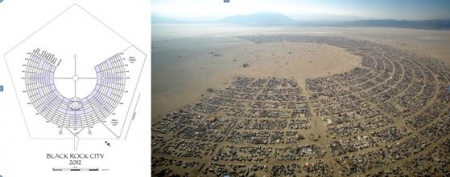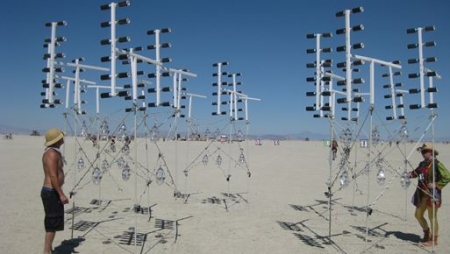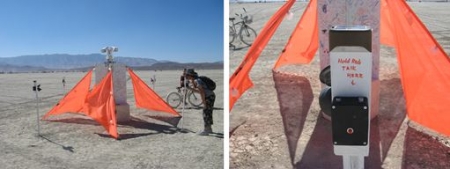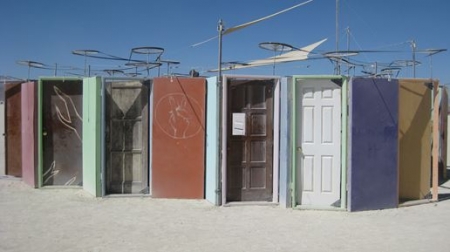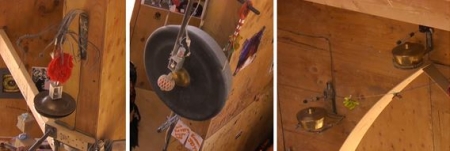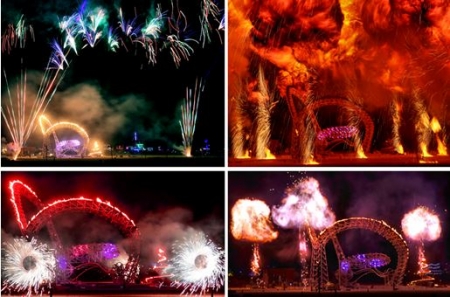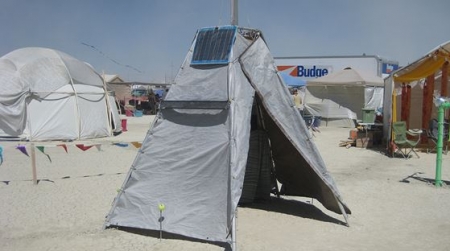- accueil >
- Numéros de la revue >
- Musique et écologies du son. Propositions pratique... >
- Artistes de l’écologie du son >
Sound Art at Burning Man:Sonic Interventions in an Extreme Environment
Stephan Moore et Scott SmallwoodDOI : https://dx.doi.org/10.56698/filigrane.695
Résumés
Abstract
The Burning Man Festival occurs annually in the Black Rock Desert of Nevada in the US during the week leading up to Labor Day, which occurs on the first Monday of September. The festival began in 1986, and has evolved to become a city of interactive artworks created by participants who agree to build, live in, celebrate, and then remove all traces of the event. Recent years have witnessed a large array of works that employ sound as an important, and often primary, component. These works range from acoustic-object sound installations to works that use amplified sound and varying degrees of electronics. Many are installations that easily become sites for performance and expression by participants who encounter and interact with them, and some works play off this explicitly. Others take the form of sounding devices that respond to their environment as a whole. There are also a number of instrument designers and inventors who bring new creations to share with the community. Each exists within, and plays a part in, Burning Man's unique urban soundscape. Here, we will investigate the various critical environmental and social factors that must be taken into account when creating sound-based artworks for Burning Man, through the lens of several representative examples from recent festivals, including work created by the authors.
Texte intégral
Introduction: The Art of Burning Man
1The Burning Man Festival began as a small gathering in 1986 on the beach in San Francisco, and moved to the Black Rock Desert in the US state of Nevada in 1991. Initially just a few dozen participants, the annual eight-day event has grown into a multifaceted festival of art and expression that is expected to reach 60,000 participants in 2013. Festival attendees are asked to embrace ten principles1 which include radical self-expression, participation, and immediacy, meaning that most participants come prepared to create, contribute, and interact with artworks, performances, and activities of all types. Many of the artworks created for the event are site-specific, incorporating and often leveraging the event’s annual theme, various recurring memes that characterize the event (e.g. fire), and the challenging environmental conditions presented by the desert and its temporary inhabitants. We begin our discussion by orienting the reader to the festival and the varieties of artwork it features. We then discuss the various factors that must be considered in the preparation, construction, and modes of interaction of sound works at Burning Man. This is followed by a brief survey of sound-oriented works at Burning Man, citing some representative examples. Finally, we discuss some of our own experiences and observations as artists bringing interactive sound works to the playa.
Description of the event
2To appreciate the challenges and opportunities facing artists at Burning Man, is important to understand the general layout of the event, as well as the basic trajectory of the creation, celebration, destruction, and removal of the city and its artwork, inhabitants, and support structures. Black Rock City, as the festival site is known to its citizens, is fully a city in conception, form, and function. It has a functional zip code (US postal code) and a working post office and a volunteer postal delivery operation. It has a street system, and residents have addresses. There is a small electrical grid, a landing strip, a public works department (DPW), peace officers (the Black Rock Rangers), and distributed health, fire, and safety services, among others. Numerous daily newspapers and radio stations flourish each year. The Burning Man organization itself provides some minimal infrastructure, including the layout and maintenance of the streets, distributed “porta-potties,” and Center Camp, a social space and nexus for information services. However, most of the civic and social services in the city are staffed by volunteers, or invented and provided by the participants themselves. As such, these services may be packaged with a unique artistic flair. For example, the Lamplighters, who provide streetlights to the main thoroughfares, do so by performing a daily procession through the city, using gas-powered lanterns which are ceremonially distributed, lit, and hung in place each evening before dark.
3Example 1 below shows the basic map of the city next to an aerial overview, both of which display Black Rock City’s layout in 2012, which supported a peak population of 56,149. The streets are arranged in concentric circles, crossed by streets radiating from the center, starting (in a clock face analogy) at 2:00 and ending at 10:00, making the city relatively easy to navigate. This system is organized around a central point—the “man” effigy itself. As a tall, distinctive, and well-lit structure at the center of the city, the “man” serves as an important visual landmark, orienting citizens in the city’s open areas and radial streets. The dramatic burning of the “man” on the sixth night of the festival is the pyrotechnic climax of the event, and its disappearance touches off the week’s most intense celebrations, while simultaneously signaling the beginning of the city’s immanent demise through the loss of its center.
Example 1. Aerial overview of Black Rock City, 2012 (Photo by Reuters/Jim Urquhart).
Types of Artwork
4It is difficult to pigeonhole the wide variety of artwork and artistic activity found at Burning Man, but here is one attempt at a comprehensive categorization:
5Sculpture, in a wide variety of materials, a favorite being wood, of course, since often the pieces are burned during or after the festival.
Shelters, architecture, social spaces. Many artists create pieces that create a social space, as well as an escape from the hot sun and wind.
Interactive art, utilizing many varieties of technology, ranging from non-electronic work, to the very analog, to the very digital.
Kites and inflatable art. Many kite enthusiasts bring the most amazing variety of kites, balloons, and other inflatable/airborne objects, as the intense winds and lack of geological surface obstacles make this activity both challenging and intensely rewarding.
Painting and other 2-D art. Many galleries exist throughout the city in which can be found large varieties of 2-D artworks.
Performance. Many works include theatrical and/or musical performances. Bands and DJs, of course, fit into this category, but there are also numerous events such as the daily hanging of street lights by the Lamplighters, who process around the city in white robes, in a kind of somber, ritualistic manner.
Games. These include everything from dodge ball courts with organized tournaments, to giant projected Tetris matches, to the infamous Thunderdome, a structure inspired by the post-apocalyptic Mad Max movies in which two opponents battle on bungie swings using padded bats before a rowdy audience.
Theme camps. These are located in the city proper, usually in the inner core, and they either house the personnel who build and maintain the larger interactive art works, mutant vehicles, etc, or they are destinations in themselves. DJ clubs, themed bars and food establishments, amusements such as Black Rock Roller Disco, yoga camps, hair salons, and anything else participants can imagine can be found. These camps must participate in the Black Rock City gift economy, in observance of another of the ten principals: non-commercialism. All services, drinks, food, games, and performances – any transaction at all – must be given away for free. Even barter is discouraged in this gift economy ethos.
Mutant vehicles/art cars. In Black Rock City, motorized vehicles are prohibited, so most citizens transport themselves on foot, or via bicycles. An exception is made, however, for mutant vehicles, which must be significantly modified from their original forms into works of art. These vehicles are not allowed to move faster than five miles per hour, and often serve as public transportation or mobile celebrations.
Fire is an important medium at Burning Man, and much of the artwork is designed to incorporate flames. Much burning of artwork has a practical aspect, as it is the most efficient method of removal from the event. But many pieces are also designed specifically to burn aesthetically, creating beautiful and strange spectacles. Many fire-based artworks are not themselves flammable, but make use of pyrotechnic technologies such as arrays of propane gas jets. A special issue of Leonardo chronicles some of the highlights of fire-based artwork on the playa (L. Brill and LadyBee, 2007).
6While these categories help to illustrate the breadth of projects participants bring to the playa, they also oversimplify the complexity and individuality of the work, as many pieces exist in multiple categories, or “none of the above.” Accordingly, the event brings together artists of all ages, experienced and novice, some of whom normally exhibit in traditional gallery environments, as well as those who are so-called “outsider artists,” to show their work on the playa every year. In general, these “default world” distinctions are necessarily blurred at this event, since art-making “is not viewed as the sole province of trained, educated specialists, as it is in the institutionalized world; it is part and parcel of everyday life for the citizens of Black Rock City, nearly all of whom produce objects for use and display during the event, from costumes and small items given out as gifts to large-scale art installations.” (C. Kristen and LadyBee, 2006).
Although we include no images of non-sound-oriented artworks here, many good sources exist online and in publications such as (J. Bruder, 2007), (L. Nash, 2007), and the aforementioned Leonardo special issue (L. Brill and LadyBee, 2007). Several documentary films2 have emerged over the last few years, some of which show and discuss the process of creating artwork for the playa.
Participation
7The Burning Man community places a high value on participatory experiences, and artists share their work with the expectation that the public will approach it as interactive by default. Sculptures will be climbed, structures entered and occupied, vehicles ridden, games played, and puzzles investigated. Artists desiring this sort of interaction find Burning Man to be an ideal venue for their projects. At the same time, the community tends to take its artwork work seriously and treat it with respect. Defacing art is frowned upon and avoided, although the authors have occasionally seen artwork cited by the “art police,” or given other wry, non-vandalizing commentary.
In addition to interactive artworks, of course, there are numerous participatory activities: talks, competitions, yoga and exercise, classes, even academic conferences that may not be explicitly artistic, but are usually infused with an artistic, non-conformist spirit. Organizers of such activities learn to expect a certain amount of intervention as participants fulfill their roles and art projects collide. At one academic talk attended by the authors, which took place in a large geodesic dome structure, the audience was suddenly invaded by a group of ten or so naked people covered in blue body paint, who suddenly appeared at one entrance and silently climbed through the crowd to the other side, disappearing as quickly as they had arrived. Such acts of participation are both widespread and completely unpredictable at any moment. They are hallmarks of the event, making it a unique place to engage in presenting works or ideas of any kind.
Sound Art at Burning Man
8In addition to the huge variety of musical performances that happen at the event—a separate subject which deserves attention elsewhere—the event boasts several works of art each year that employ sound as an important, and often primary, component. The work ranges from acoustic-object sound installations—often based on bells, invented or repurposed instruments, wind harps and chimes of endless varieties—to works that use amplified sound and varying degrees of electronics. Most are installations that, while not performative in isolation, easily become sites for performance and expression by participants who encounter and interact with the works. Some works play off this and invite it explicitly. Others take the form of sounding devices that respond to their environment as a whole. There are also a number of instrument designers, inventors, and experimenters who bring new instrumental creations to the playa and perform with them. In all cases, the extreme nature of the event requires careful planning and conception.
The Environment
9Several factors inherent in the event’s physical and social environment complicate the endeavor of installing and maintaining any artwork at Burning Man. The difficulty of transporting work to the event’s remote location, and the potential for high winds, temperature extremes, dust storms, and even the occasional rainstorm, must all be taken into account. The extreme heat and dust can prove fatal to sensitive electronics, and the hard crusty earth, while capable of producing endless amounts of white-out inducing dust during high winds, can be quite challenging to drive stakes into. Special alkali-resistant materials should be used, and special care should be given to ensure that structural parts can take a beating and not come loose.
As mentioned above, most effective artworks at Burning Man are necessarily interactive on some level, or become so, as participants will not hesitate to touch, climb on, and commune with the work in any number of novel manners. Though this interaction is mainly good-natured and stops short of intentional vandalism, it can be extreme, and the artist should prepare their work for anything and take safety into account. For example, structures should be made sturdy enough to be climbed, or should be formed so as to discourage climbing.
Black Rock City never sleeps, and participants may attempt to interact with artwork at any time of day or night, unless a piece can be clearly shut down or removed by the artist at desired times. Artwork must therefore be illuminated at night to allow for the desired interaction. Illumination should also serve a defensive at night, to prevent damage and possible demolition by running or biking participants without headlights, or, even worse, a collision with an off-course mutant vehicle. The open desert does not offer electrical power, other than whatever may exist as part of the temporary city. There are three areas designed as public plazas where an electrical grid exists, provided by the Black Rock City public works department, but participants have limited access to it, in accordance with the principle of radical self-reliance. Artworks that have power needs greater than what can be provided by batteries require gas-powered generators and enough gasoline for the duration of the event, or the use of solar- or wind-generated power.
A “Leave No Trace” ethic is in full force at Burning Man, as another of the ten principles observed by the citizenry, and this has a significant impact on planning for the event both as a participant and as an artist showing work. Participants are expected to pack out all of their own trash and vigilantly recover and dispose of litter that may be on the loose in the wind, known as MOOP, or “matter out of place.” Artwork must not generate MOOP of any kind, such as feathers, dried grasses, loose threads from textiles, etc. Leave No Trace practices affect the burning of objects as well. Artists who wish to burn their art are required to ensure that the playa itself is not scorched by bringing in large piles of dirt or gravel on which to host the fire. This buffer material must be removed by the end of the event, along with any remaining ash and other vestiges of the burn. Participants with large theme camps and artworks are evaluated on both their pre-event cleanup plan, and their post-event follow through. Failure to meet standards can result in the Burning Man Organization declining to sanction a theme camp’s or artist’s future art projects.
With such a multitude of discouragements facing the would-be Burning Man artist, one might wonder that any choose to participate. However, many artists find inspiration in these constraints and choose to exploit or even transcend them, innovating around environmental difficulties in often surprising and creative ways, overtly incorporating or cleverly concealing the means by which the various challenges are overcome. As artists return to the event year after year, their experience in dealing with these circumstances increases and the artwork’s savvy evolves. In the next section, we illustrate this innovation through a brief survey of sound-oriented artworks from 2011.
Some Specific Sound Artworks
Example 2. A Chorus of the Winds (2011), by Thomas Trower (Photo by Scott Smallwood).
10A Chorus of the Winds, located in the deep playa, reprised and combined two previous works by artist Thomas Trower (see example 2). An open circle of thin but sturdy wire structures contained dozens of dangling plastic bottle-like objects that caught the wind and spun easily. The structures also supported a host of “singing weathervanes,” as Trower calls them, which rotated with the direction of the wind. Air blowing past the open aluminum bottles produced a ghostly whine to accompany the gentle whirring sound of the spinning plastic bottles. This piece was most striking during the day, as the sun striking the geometric surfaces of the plastic spinners unleashed swarms of bright, sparkling reflections. At night, the structure was bathed in a ghostly but sufficient illumination afforded by dim white LED lights.
Aural Conflagrator was an interactive electronic piece consisting of four stations arranged around a central structure, topped by a cluster of loudspeakers (see example 3). Each station consisted of a button-activated microphone that participants could speak or sing into. The participant-contributed sounds were then incorporated into an ongoing audio stream emanating from the structure, fragmented and electronically modified/processed and played back at various speeds. The piece seemed to privilege sounds that were recently recorded, ensuring that participants heard their own sounds immediately, but also incorporated a fair amount of sound from earlier in the event, in what seemed to be a “long-term memory” part of the stream. The central structure had large white surfaces, and participants were invited to decorate it with writing or imagery using permanent markers attached to the structure by strings, creating an analogous long-term visual memory of participant interactions with the piece. The piece also included four large orange flags attached between the central structure and the ground. Flapping in the constant wind, the flags made a significant contribution to both the visual and sonic presence of the work. Lighting was provided by strings of durable LED globe lights stretched along the tops of the flags, and power was supplied by a solar panel in combination with a battery.
Example 3. Aural Conflagrator (2011), by Chromatest Pantsmaker
(Photo by Scott Smallwood and Stephan Moore).
11Another Door was an example of installation with a sound component that was possibly unintentional, but was nevertheless quite remarkable and essential to the experience of the work. The piece consisted of a complex structure of wooden doors attached to a network of pulleys mounted above the doors, made out of bicycle wheels and large rubber belts (see example 4). The doors were connected such that opening one door caused another door somewhere in the structure to close, and vice-versa. The structure was maze-like, with all paths leading to a central alcove that became a shelter and gathering space. Sitting inside on benches, one could listen to the sound of squeaky wheels from the overhead pulley system, and the creaking and slamming of doors all around the space.
Example 4. Another Door (2011), by Calen Barca-Hall (Photo by Scott Smallwood).
Example 5. Transportals (2006-11), by Harlan Emil Gruber
(Photos by Scott Smallwood and Harlan Emil Gruber).
12Brooklyn-based artist Harlan Emil Gruber’s various Transportals have made appearances on the playa for many years now, and are generally made up of wooden geometrical structures which, similar to the work above, host spaces for personal reflection or intimate social interactions3. This type of work represents a theme of many artworks in the deep playa, where participants are encouraged to sit and rest, have a quiet conversation, or even to sleep (see example 5). The Transportals have mostly been relatively small structures, seating between five and eight individuals comfortably, but the Sapphire Portal of 2008 was quite large, and took the form of a large circular building. Each of the Transportals is based on a carefully-controlled feedback loop, where a bass guitar, laid flat beneath the structure and out of view, is amplified through large speaker elements coupled to the structure, and the resulting vibrations cause a sympathetic response the strings of the bass. In the case of the larger Sapphire Portal, the bass was located inside of the inclined walls against which participants sit. Low frequencies from passing art cars or participant actions can serve to alter the characteristics of the low, droning sounds, opening them to a kind of environmental interactivity that can be eerie to perceive. The gentle massage of bass frequencies resonating through the structure and into the bodies of those sitting inside or against the structure incites a meditative, multisensory response that comes to define the experience.
Example 6. The Gamelatron (2011), by Aaron Taylor Kuffner (Photo by Scott Smallwood).
13Among the more ambitious works at the 2011 event was the remarkable Gamelatron, a large-scale installation that was featured inside the central structure, the so-called “soul,” of the Temple (see example 6). The Temple is one of the annual pieces of the event that represents a spiritual refuge, a place where one can meditate, rest, and leave notes or other memorabilia in honor of friends, lost loved ones, etc. It is burned in a silent ceremony on the last night of the event. The 2011 Temple was named the Temple of Transition, and was designed and built by a group calling itself the “International Arts Megacrew.” The Gamelatron, created by Aaron Taylor Kuffner, claims to be the world’s first fully robotic gamelan orchestra4. It consisted of 57 gongs and cymbals mounted into the walls of the structure in concentric circles. The instruments were activated by computer-controlled solenoids, and these were triggered in sequence as part of a 2-hour composition—composed on-site by the artist—that played on a continuous loop day and night throughout the event. This space was a primary site of meditation and spiritual respite, and often included the sounds of participants’ voices as they sang, drummed, and shouted along with the music. Kuffner has since exhibited this piece in many other venues.
14The Flaming Lotus Girls, an all-female arts collective from San Francisco, have created fire-based mechanical artworks for Burning Man since the year 20005. One of their most successful works, the Serpent Mother of 2006, was featured prominently in the above-mentioned special issue of Leonardo Journal, which focused on the fire-based artworks of Burning Man (L. Brill and LadyBee, 2007). Each year their work is a central feature of the inner Esplanade, and often features a major performance event that incorporates the flame-throwing and blasting capabilities of the primary mechanical sculpture mixed with state-of-the-art pyrotechnics. The 2011 piece, entitled Tympani Lambada (see example 7), featured an enormous ear-like structure, complete with a spiral cochlea, which shot colored jets of fire as well as some of the most amazing, sound-oriented fireworks. The artists focused the fireworks display not only on visual intensity, but also on the sonic nature of fireworks, creating some of the most stunning sounds of the entire event.
Example 7. Tympani Lambada (2011) by the Flaming Lotus Girls. (Photos by Steve Fritz)
Examples of Work by the Authors
15In 2007, the First Transdimensional Bank theme camp was inaugurated, and was expanded to become the First Transdimensional Bank & Church in 2008. Consistently located near the 3 o’clock plaza, this camp, organized by the authors and many others, features an interactive sound installation called the Karmic Teller Machine or KTM(see example 8). Although it is not possible to make karmic deposits or withdrawals using this installation, Black Rock citizens are able to check their karmic balance here 24 hours a day (S. Moore, Ogawa, and Smallwood, 2011).
The experience of the piece is simple: a passer-by enters the booth and is presented with a button labeled “Inquire.” If they press it, they are presented with an immersive 30-second sonic experience. What the listener takes away from this is up to them. Often, their experience is the starting point for a more elaborate interaction with members of our camp, who are usually nearby, ready to answer questions.
Example 8. The Karmic Teller Machine (KTM) (2008-13), by FTB&C (Photo by Scott Smallwood).
16The platform gives us, as composers, an opportunity to present short sound works to an intimate audience in a casual setting. Each year we add new sounds to the KTM based on the artistic work we have created in the previous year: excerpts from pieces or field recordings, anomalous or fascinating found sounds, and the like. Other members of our camp have also begun to contribute sounds to the piece. In this way, the KTM grows and gains “experience” over the years, while maintaining its past as well.In terms of playa-specific preparations, there are many factors that have had to be addressed in the design and implementation of the KTM. Since we aimed for a booth-shaped, free-standing structure, immunity to high winds was among the most important considerations. The structure of the KTM is essentially a five-sided cone, which sits upright on its base, apex to the sky. The structure’s frame is made of 2-inch diameter galvanized steel pipe. Even untethered, the structure holds up remarkably well in high winds, and has never budged, even in times of crisis when all of our other structures were under threat. Within the booth, a shelf holds the KTM’s main box, button on top, and electronics sealed inside. The sounds play back on a solid-state mp3 board controlled by an Arduino-based software program. The amp, which also lives inside the box, powers a small pair of loudspeakers, which are mounted inside of the KTM. We have learned the hard way that mechnical parts can easily malfunction, and electronics can be eaten away by the intense dust, so we have tried to implement components with no moving parts, with low heat/electrical draw, and sustainable power via solar panels mounted above.
17 The KTM has survived five years of Burning Man, but not without incident. In 2012, the power regulator expired, and an electrical workaround had to be improvised in order to restore power. Each year we learn and are able to refine the work based on experiences from the previous year, and the piece thereby evolves. In this way, the piece becomes a microcosm of Black Rock City, which is also under constant revision and refinement.
In addition to the KTM, our theme camp supports other artistic projects, serving as a kind of residency and development space for the authors and others. Both of us have brought individual projects to the playa to exhibit, test, experiment with, and reflect upon within the environment and its attendant soundscape. Smallwood’s solar noise instruments make an appearance each year via the Full Solar Salvation ensemble (S. Smallwood, 2011), and both authors have created work based on or inspired by the soundscape of the event, making use of field recordings (S. Moore and Smallwood, 2012). Many members of the First Transdimensional Bank & Church have brought works and performances to the camp, including a group of new members who are building a “light organ” for our camp’s chapel this year.
Conclusions
18Burning Man, taken as a site for artistic expression, participates in several ongoing trends – the rise of site-specific artwork, the gravitation towards of alternative presentation venues, and the inclusion of sound as a critical component of artworks. Through its extreme environment, the nature of interaction that the event engenders, and the tendency of artists to think of Black Rock City as a kind of “home,” artworks enjoy a special kind of life at the event, and are encouraged to evolve and absorb both cultural and ecological experience. This in turn fosters a unique flavor of innovation that is fascinating to both observe and participate in.
Bibliographie
Brill, Louis M. and LadyBee (eds) (2007): “The Fire Art of Burning Man”, in Leonardo vol. 40 n. 4.
Bruder, Jessica (2007): Burning Book: A Visual History of Burning Man. New York, Gallery Books.
Kristen, Christine and LadyBee (2006): “Reconnecting Art and Life at Burning Man”, in Raw Vision vol. 57.
Moore, Stephan and Scott Smallwood (2011): “The Soundscape of Burning Man,” in Soundscape Journal 11.
Moore, Stephan, David Ogawa, and Scott Smallwood (2011): "Metafiscal Services in the Middle of Nowhere." Unpublished paper, presented at the Radical Aesthetics and Politics: Intersections in Music, Art, and Critical Social Theory, Hunter College, CUNY.
Nash, A. Leo (2007): Burning Man: Art in the Desert, New York, Harry N. Abrams.
Smallwood, Scott (2011): “Solar Sound Arts: Creating Instruments and Devices Powered by Photovoltaic Technologies”, in Proceedings of the New Interfaces for Musical Expression (NIME) Conference. Oslo, Norway.
Notes
1 See http://www.burningman.com/whatisburningman/about_burningman/principles.html
2 The most notable major documentaries are Gifting It: A Burning Embrace of Gift Economy (2002), Burning Man: Beyond Black Rock (2005), Dust & Illusions (2009) and Spark: A Burning Man Story (2013). Many shorter, self-produced films are available online at YouTube, Vimeo, Kickstarter, etc.
Citation
Auteur
Quelques mots à propos de : Stephan Moore
Quelques mots à propos de : Scott Smallwood


